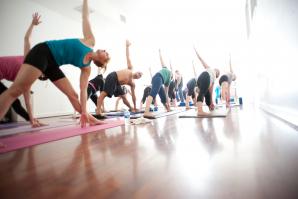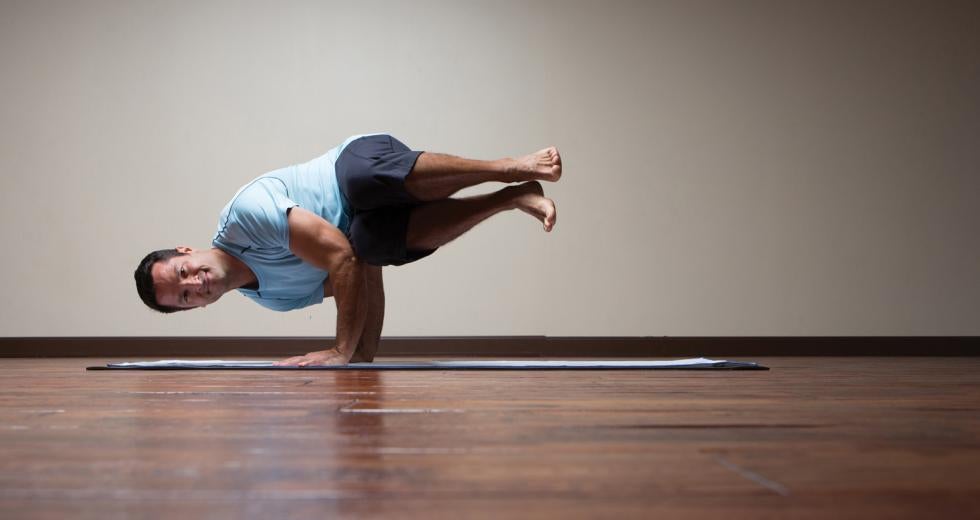I’ve always snickered at yoga. It just seemed ridiculous. Like a certain generation of men, I’ve long had a knee-jerk, irrational aversion to the practice.
In my book, Maxims of Manhood, a tongue-in-cheek etiquette manual, I included Maxim 36: “You don’t trust this ‘yoga.’” My opinion had no logic. I cited no evidence. But yoga just seemed … wrong, the way it seems wrong for a man to wear Capri pants, enjoy Justin Bieber or order a frozen drink with an umbrella. Yoga is for girls.
Clearly, I’ve been wrong. Men are flocking to yoga the way we once, in the ’80s, took to this thing called “jogging.” We’re learning that yoga bestows a slew of health benefits — physical, mental, even sexual. But new research also points to increased health risks for men, and this muddies the decision.
Should we, or shouldn’t we? (Please say we shouldn’t.)
Sweat drips from my face. It drenches my towel and soaks my yoga mat. Thirty seconds into my first session, I peel off my shirt, blinding the room with my shiny whiteness. How am I sweating this much? I served in the Marine Corps Reserves. I ran a marathon. I rode in a 100-mile bike race. But I’m not sure I’ve ever sweated as much as I do in my first hour of yoga.
I chose Bikram yoga, or what I call death yoga, the style that cranks up the heat like a sauna so that it can, according to the introductory email I got from the studio, “protect the muscles for safe, deep stretches, allowing you to work deeper to see faster results. Heat takes the trauma out of stretching, aids in healing and helps prevent injuries.” Frankly, I’m a little nervous about phrases like “the trauma of stretching.”
So I enter the class with two key objectives: 1) Do not pass out; 2) Do not pass gas. The session is half women, half men, and I sort of feel cheated. (At the risk of sounding like Creepy Yoga Guy, we can all agree that eye candy is at least some of the appeal, right?)
But I shouldn’t be surprised to see a class full of dudes. Male yogis are everywhere. Athletes like Lebron James, Steven Jackson and Kevin Garnett spruce up their training routines with standing forward bends and downward-facing dogs.
“I had some lower back problems a few years ago, and once I started to do the yoga, it has helped them go away,” gushed Labron. Kevin Garnett went even further, saying, “I’ve been doing yoga since 1995, and I practice my breathing and focusing exercises before every game.”
More and more men in the Captial Region are giving it a shot, too. “We have about 20- to 30-percent men. It’s so exciting to see. There’s less of the misconception that yoga is for pansies,” says Ann Marie Kramer, the owner of Zuda Yoga, which has studios in midtown, Folsom and Roseville. “That stereotype is no longer there. Men are saying, ‘I want to feel more relaxed, I want to feel better.’ And they realize that you don’t have to chant and do things like that.”
Marketers are quick to jump on the trend. “Broga,” yoga for bros, has a tagline that includes, “It’s okay if you can’t touch your toes.” Their programs (“brograms”) tweak the usual routine to focus on core strengthening, muscle toning and cardio. Or maybe you’d prefer to do man yoga in the comfort of your own home? No problem. DVD options include, “Yoga for Men,” “Yoga for the Warrior,” “Men’s Back Health Through Yoga,” “Yoga for Athletes,” and, well, for the sake of thoroughness, a gamut of choices like “Loving Sex: Erotic Yoga for Couples — Intimate Routines for Great Sex.”
The Benefits
“Touch your toes! Extend your hips!” my instructor chirps.
She speaks fast. Crazy fast. Thanks to clichés from movies and sitcoms, I was imagining slow, soothing instructions and dim lighting. Instead, she speaks with the rapid-fire delivery of an auctioneer: “Keep the heels together and relax your toes, move the hips up, point to the mirror, relax your spine, interlock your thumbs, squeeze the glutes, bend backwards, look behind you, palms up!”
I’m completely lost. I steal glances at the other yogis who are contorting their bodies into sweaty pretzels. How do you “relax your spine?” I get frustrated and wonder, ‘What’s the point?’
The point, of course, is the never-ending list of health benefits. Even — and perhaps especially — for men.
“Men have a tendency to become stressed or aggressive. Yoga can
help
get rid of that stress and aggression. And this can lead to
mental clarity,” says Tyler Langdale, the owner of Sacramento’s
Yoga Shala. He routinely sees men who are surprised to find that,
after sticking with yoga, other aspects of their lives improve.
“A dad might say, ‘Hey, I’m actually more present with my kids.’
And that’s huge,” he says.
If you think yoga is only for effete men who listen to Enya and chant, “Ohhhhhmm,” tell that to Toraino Singleton, a beastly ex-NFL player who owns Innovative Strength and Conditioning, a no-frills gym in Sacramento.
“Back in the day, when I would hear the word yoga, I thought, well, that it’s not a manly thing. That I didn’t need it,” Singleton tells me. Then, last February, he ruptured a disc in his back. Playing football from the age of 6 to 26 had taken a toll, and his doctor told him that the injury was caused, at least in part, by a lack of flexibility.
So, at age 40, he turned to yoga. “I noticed a huge difference after just a few sessions,” he says. “Since I’ve been doing it, my body just feels good. My knees don’t ache. My lower back is more comfortable.” I was surprised to hear that it has made him stronger, too. The increased flexibility gives him better form when weightlifting. Singleton says that, thanks to yoga, he can dead squat more weight than he has in years.
And yes, sure, you can also get that highly coveted peace of mind. Take Yoga Shala’s co-owner, Josh Pane, who’s also a veteran lobbyist, consultant and city councilman.
“I’ve noticed that I’m less stressed and worried about what may or may not be coming, whether it’s work, family or life in general. I recognize that this moment is the moment. So I’m grateful for it, cherish it, accept it. It helps me embrace and enjoy.”
Yoga works every part of the body. Men are prone to hit the gym and just focus on specific muscle groups, like their arms or abs. This often ignores the tiny stabilizing muscles crucial to overall strength and achieving elite-level fitness, and study after study has shown that yoga can increase our range of motion, make us leaner and, well, help us look better naked.
It can also make us happier. When scientists studied the neurons and brain patterns of yogis, they found that it fires up neurotransmitters that serve as antidepressants. It also boosts the amount of telomerase, an enzyme in the body that helps our cells live longer. It might even make us more creative; a 2009 study found that yoga fires up the right side of the brain, which is responsible for imagination, understanding abstract concepts and spontaneity.
And finally, yes, it can improve your sex life. A 2010 study in “The Journal of Sexual Medicine” took 65 men, enrolled them in a 12-week yoga program and found that the men reported improvements in “all the domains of sexual functions as studied … desire, intercourse satisfaction, performance, confidence, partner synchronization, erection, ejaculatory control and orgasm.” So, yea, there’s that.
The Risks
As I struggle to point my left foot to the sky while keeping my chin on the yoga mat, I’m reminded of some exercises we did in Marine Corps boot camp. Actually they weren’t really exercises, per se, but punishments. When they wanted to teach us a lesson, the drill instructors would order us to pick up our M16s with just our pinky finger, and then we’d hold the rifles away from our bodies until our fingers and arms were shaking with pain. Yoga is basically the same thing.
Or, more precisely, boot camp is like yoga for Type-A men who like to push things too far. Men’s competitive, limit-pushing tendencies explain why they experience far more yoga-related injuries than women.
In his book, “The Science of Yoga: The Risks and Rewards,” Dr.
William Broad, a veteran science reporter for The New York Times,
suggests yoga might not be the panacea it claims. He sparked a
controversy in the yoga community, reporting, “Yoga has produced
waves of injuries. Take strokes … Doctors have found that certain
poses can result in brain damage that turns practitioners into
cripples with drooping eyelids and unresponsive limbs.”
Ouch.
Dr. Broad argues that men are especially at risk. “Science has long viewed the female body as relatively elastic. Now, the [new research] suggests that women who tie themselves in knots also enjoy a lower risk of damage.” His analysis found that even though men accounted for 16 percent of the yoga population between 1994 and 2011, they somehow accounted for 24 percent of yoga-related injuries. More strikingly, men account for 70 percent of injuries related to nerve damage. Men are anatomically less flexible than women (particularly in the pelvic region), and they’re also more likely to push themselves too far, too fast. It’s not a good combination.
Besides, the goal isn’t to “win” at yoga. The benchmarks are relative. Joel Strehle, 41, has been teaching at Zuda Yoga for years — and he can’t touch his toes. His body just isn’t built that way.
“My hips are tight. I do a lot of sports — running and cycling. And even though I practice yoga four or five times a week, there are still times when I feel bone-on-bone,” he says. “The way my femur connects to my hip-bone, it doesn’t allow me to do any more movement beyond that. My elbow’s the same way; my shoulder’s the same way. But I love the way my body’s made, and I’m okay with it.”
Strehle says that instead of focusing on what the body can’t do,
he focuses on what it can. “Even though I can’t touch my toes, I
still get a stretch, still get a release. And it’s a
process. It’s a long
journey. It took me 41 years to own a BMW, to own my house and to
have an awesome wife,” he laughs. “Nothing happens overnight. And
not yoga. It’s a 5,000-year-old process. The truth is that when I
finally touch my fingers to my toes, I’m not going to be any more
enlightened.”
Trimming the Risk
So is this risk really a concern? Is it a valid reason to skip yoga? Probably not. There’s also risk in basketball, tennis, running or flying a kite.
“If you move your body, you’ll get injured. Show me any single activity where no one ever gets hurt,” says Kramer, adding that, since yoga is about self-awareness and personal responsibility, it ultimately reduces the risk of injury.
Even the skeptic Dr. Broad — who has practiced yoga for years — comes to the same pro-yoga conclusion. “The benefits unquestionably outweigh the risks. The discipline on balance does more good than harm,” he concedes. “Still, yoga makes sense only if done intelligently so as to limit the degree of personal danger.”
That’s the real trick. It’s up to men to accept their limitations and work within their physical boundaries. Langden says the biggest cause of injuries is simple: Forcing the issue. The best way to avoid that risk is simple self-awareness. “Bring with you the same level of awareness that you would when you’re doing a squat or a dead-lift,” Langden says. “If you bring that awareness to yoga, you’ll be okay.”
If you’ve never used a chainsaw before, it’s generally wise to
read the instructions. Yoga is no different. “If you’re going to
buy a tool, you damn well figure out how to use that tool. Yoga
is a practice of skillfully refining your body and the way that
you move it,” Langden says. “That’s going to take a bit of
patience and awareness. Make sure you’re listening.”
Speaking of listening … The class feels like it’s been dragging
for seven hours, and I’m starting to fade. The instructor’s
yelling like my drill sergeant, “Point to the mirror! Pull in
your chest! Squeeze the glutes! Relax the spine!” has left me
frustrated with my own lack of bodily awareness. I’ve sucked down
two bottles of water and could easily chug a third.
And then, finally, it’s over.
“You did it, Jeff!” the instructor says, and she leads the class in a polite round of applause. Aww. If I didn’t feel like puking, I’d be touched.
Would I do it again?
Yes and no. On the one hand, this is clearly out of my comfort zone. It doesn’t feel like me. When I’m working out, I want to go-go-go! and run somewhere, lift something, jump, sprint, swim or dive for a tennis ball. I want to be as active as possible. Yoga demands stillness, and I find this stillness intolerable. I lack the patience. I lack the focus.
On the other hand, this very go-go-go mindset, paradoxically,
means yoga is precisely for me. I probably need it more than
most. Yoga would force me to slow down, focus (really focus) and
silence the noisy radio of life’s distractions. I could use more
patience.
I should be more aware.
In other words, if I were more of a man, I’d do it every day.
Recommended For You

Posed for Growth
Sacramento's yoga market thrives
In a Thursday morning’s darkness, the hardwood floor of Yoga Shala is covered wall to wall in rubber mats. Seated, students center their breath as instructor Tyler Langdale begins the Vinyasa class.

Flexible by Definition
Pilates maintains popularity and expands its reach
When Kelly Sassman started giving Pilates instruction at her Sacramento studio 12 years ago, people couldn’t even pronounce the name of the fitness program.

Juiced
Bowel Formula No. 2, friend or foe?
It’s a seductive pitch: Cleanse your body. Feel healthy. Lose weight.
You only have to do one thing: starve.



